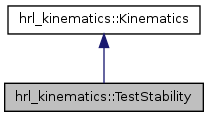#include <TestStability.h>

Public Member Functions | |
| tf::Point | getCOM () const |
| visualization_msgs::Marker | getCOMMarker () const |
| geometry_msgs::PolygonStamped | getSupportPolygon () const |
| bool | isPoseStable (const std::map< std::string, double > &joint_positions, FootSupport support_mode) |
| bool | isPoseStable (const std::map< std::string, double > &joint_positions, FootSupport support_mode, const tf::Vector3 &normal_vector) |
| void | scaleConvexHull (double scale) |
| TestStability (std::string rfoot_mesh_link_name="RAnkleRoll_link", std::string root_link_name="base_link", std::string rfoot_link_name="r_sole", std::string lfoot_link_name="l_sole", const boost::shared_ptr< const urdf::ModelInterface > &urdf_model=boost::shared_ptr< const urdf::ModelInterface >(), double foot_polygon_scale=1.0) | |
| Constructor. | |
| virtual | ~TestStability () |
Protected Member Functions | |
| std::vector< tf::Point > | convexHull (const std::vector< tf::Point > &points) const |
| void | initFootPolygon (double scale=1.0) |
| bool | loadFootPolygon () |
| bool | pointInConvexHull (const tf::Point &point, const std::vector< tf::Point > &polygon) const |
| tests if point is in polygon in 2D. point and polygon will be projected down to z=0 (z values will be ignored) | |
Protected Attributes | |
| double | foot_polygon_scale_ |
| std::vector< tf::Point > | foot_support_polygon_left_ |
| Support polygon (x,y) for the left foot (mirrored from right) | |
| std::vector< tf::Point > | foot_support_polygon_right_ |
| Support polygon (x,y) for the right foot. | |
| tf::Point | p_com_ |
| std::string | rfoot_mesh_link_name_ |
| std::vector< tf::Point > | support_polygon_ |
| tf::Transform | tf_to_support_ |
Detailed Description
Class to test whether the kinematic state of a (humanoid) robot is statically stable, given its joint configuration, support mode and the normal vector of the supporting plane.
- See also:
- isPoseStable()
Definition at line 51 of file TestStability.h.
Constructor & Destructor Documentation
| hrl_kinematics::TestStability::TestStability | ( | std::string | rfoot_mesh_link_name = "RAnkleRoll_link", |
| std::string | root_link_name = "base_link", |
||
| std::string | rfoot_link_name = "r_sole", |
||
| std::string | lfoot_link_name = "l_sole", |
||
| const boost::shared_ptr< const urdf::ModelInterface > & | urdf_model = boost::shared_ptr<const urdf::ModelInterface>(), |
||
| double | foot_polygon_scale = 1.0 |
||
| ) |
Constructor.
- Parameters:
-
rfoot_mesh_link_name - the model mesh used for displaying the foot polygon for both feet root_link_name - name of link that is base of robot rfoot_link_name - name of link that is considered the right foot lfoot_link_name - name of link that is considered the left foot urdf_model - a pointer to a pre-loaded URDF model that can speed up initialization if provided foot_polygon_scale - default 1.0 - determines the safety margin of the foot support polygon
Definition at line 41 of file TestStability.cpp.
| hrl_kinematics::TestStability::~TestStability | ( | ) | [virtual] |
Definition at line 52 of file TestStability.cpp.
Member Function Documentation
| std::vector< tf::Point > hrl_kinematics::TestStability::convexHull | ( | const std::vector< tf::Point > & | points | ) | const [protected] |
Definition at line 154 of file TestStability.cpp.
| tf::Point hrl_kinematics::TestStability::getCOM | ( | ) | const [inline] |
- Returns:
- the center of mass
Definition at line 98 of file TestStability.h.
| visualization_msgs::Marker hrl_kinematics::TestStability::getCOMMarker | ( | ) | const |
- Returns:
- the center of mass (for visualization)
Definition at line 134 of file TestStability.cpp.
| geometry_msgs::PolygonStamped hrl_kinematics::TestStability::getSupportPolygon | ( | ) | const |
- Returns:
- the support polygon (for visualization)
Definition at line 118 of file TestStability.cpp.
| void hrl_kinematics::TestStability::initFootPolygon | ( | double | scale = 1.0 | ) | [protected] |
Definition at line 217 of file TestStability.cpp.
| bool hrl_kinematics::TestStability::isPoseStable | ( | const std::map< std::string, double > & | joint_positions, |
| FootSupport | support_mode | ||
| ) |
Test stability based on center of mass and support polygon, assuming the robot is standing on a horizontal supporting plane.
- Parameters:
-
joint_positions given robot configuration support_mode which foot the robot is standing on (SUPPORT_SINGLE_RIGHT, SUPPORT_SINGLE_LEFT, SUPPORT_DOUBLE)
- Returns:
- true if pose is stable
Definition at line 56 of file TestStability.cpp.
| bool hrl_kinematics::TestStability::isPoseStable | ( | const std::map< std::string, double > & | joint_positions, |
| FootSupport | support_mode, | ||
| const tf::Vector3 & | normal_vector | ||
| ) |
Test stability based on center of mass and support polygon, assuming the robot is standing on an arbitrary supporting plane (given by normal_vector)
- Parameters:
-
joint_positions given robot configuration support_mode which foot the robot is standing on (SUPPORT_SINGLE_RIGHT, SUPPORT_SINGLE_LEFT, SUPPORT_DOUBLE) normal_vector normal vector of the supporting plane
- Returns:
- true if pose is stable
Definition at line 61 of file TestStability.cpp.
| bool hrl_kinematics::TestStability::loadFootPolygon | ( | ) | [protected] |
Definition at line 243 of file TestStability.cpp.
| bool hrl_kinematics::TestStability::pointInConvexHull | ( | const tf::Point & | point, |
| const std::vector< tf::Point > & | polygon | ||
| ) | const [protected] |
tests if point is in polygon in 2D. point and polygon will be projected down to z=0 (z values will be ignored)
Definition at line 193 of file TestStability.cpp.
| void hrl_kinematics::TestStability::scaleConvexHull | ( | double | scale | ) |
Definition at line 338 of file TestStability.cpp.
Member Data Documentation
double hrl_kinematics::TestStability::foot_polygon_scale_ [protected] |
Definition at line 117 of file TestStability.h.
std::vector<tf::Point> hrl_kinematics::TestStability::foot_support_polygon_left_ [protected] |
Support polygon (x,y) for the left foot (mirrored from right)
Definition at line 109 of file TestStability.h.
std::vector<tf::Point> hrl_kinematics::TestStability::foot_support_polygon_right_ [protected] |
Support polygon (x,y) for the right foot.
Definition at line 107 of file TestStability.h.
tf::Point hrl_kinematics::TestStability::p_com_ [protected] |
Definition at line 111 of file TestStability.h.
std::string hrl_kinematics::TestStability::rfoot_mesh_link_name_ [protected] |
Definition at line 114 of file TestStability.h.
std::vector<tf::Point> hrl_kinematics::TestStability::support_polygon_ [protected] |
Definition at line 112 of file TestStability.h.
Definition at line 113 of file TestStability.h.
The documentation for this class was generated from the following files: